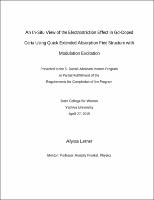Please use this identifier to cite or link to this item:
https://hdl.handle.net/20.500.12202/3975Full metadata record
| DC Field | Value | Language |
|---|---|---|
| dc.contributor.author | Lerner, Alyssa | - |
| dc.date.accessioned | 2018-10-16T19:27:06Z | - |
| dc.date.available | 2018-10-16T19:27:06Z | - |
| dc.date.issued | 2015-04-27 | - |
| dc.identifier.uri | https://hdl.handle.net/20.500.12202/3975 | - |
| dc.identifier.uri | https://ezproxy.yu.edu/login?url=https://repository.yu.edu/handle/20.500.12202/3975 | |
| dc.description | The file is restricted for YU community access only. | - |
| dc.description.abstract | As more applications are found for electromechanical materials, studying their properties becomes increasingly relevant. The presence of an external electric field can lead to a mechanical response, which is useful for a wide variety of applications, from actuators for precise scientific instruments and home electronics to transducers for audio speakers and sonars. These materials are currently limited in their voltage requirements and physical dimensions, and the next generation of electromechanical solid materials will have an increased magnitude of electromechanical response. As more effective materials, they will require lower operating voltage and be physically smaller. While properties such as pyroelectricity and piezoelectricity were traditionally attributed to certain crystal structures, it has been found that materials can form polar quasiamorphous phases as thin films, with random networks of local bonding units that can create local dipole moments. This was first demonstrated for barium zirconate (BaZrO3) and strontium titanate (SrTiO3). A similar local dipole mechanism was then observed when both gadolinium-doped ceria thin films (Ce0.8Gd0.2O1.9) and oxygen-deficient ceria thin films (CeO2-x) exhibited chemical strain effects. Upon further investigation, Ce0.8Gd0.2O1.9 was revealed to have an unusually large electrostriction effect, exceeding that of conventionally used materials. The aliovalent Gd3+ dopant creates oxygen vacancies in the material, and these vacancies are thought to be responsible for the films’ exceptional electromechanical properties, for which local dipoles are required. | en_US |
| dc.description.sponsorship | S. Daniel Abraham Honors Program | en_US |
| dc.publisher | Stern College for Women | en_US |
| dc.rights | Attribution-NonCommercial-NoDerivs 3.0 United States | * |
| dc.rights.uri | http://creativecommons.org/licenses/by-nc-nd/3.0/us/ | * |
| dc.subject | Cerium compounds | en_US |
| dc.subject | Chemical reactions | en_US |
| dc.subject | Gadolinium | en_US |
| dc.title | An In-Situ View of the Electrostriction Effect in Gd-Doped Ceria Using Quick Extended Absorption Fine Structure with Modulation Excitation | en_US |
| dc.type | Thesis | en_US |
| Appears in Collections: | S. Daniel Abraham Honors Student Theses | |
Files in This Item:
| File | Description | Size | Format | |
|---|---|---|---|---|
| Alyssa-Lerner.pdf Restricted Access | 580.37 kB | Adobe PDF |  View/Open |
This item is licensed under a Creative Commons License

